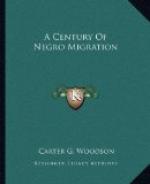Following the example of Philadelphia, Pittsburgh had a riot in 1839 resulting in the maltreatment of a number of Negroes and the demolishing of some of their houses. When the Negroes of Philadelphia paraded the city in 1842, celebrating the abolition of slavery in the West Indies, there ensued a battle led by the whites who undertook to break up the procession. Along with the beating and killing of the usual number went also the destruction of the New African Hall and the Negro Presbyterian church. The grand jury charged with the inquiry into the causes reported that the procession was to be blamed. For several years thereafter the city remained quiet until 1849 when there occurred a raid on the blacks by the Killers of Moyamensing, using firearms with which many were wounded. This disturbance was finally quelled by aid of the militia.[22]
These clashes sometimes reached farther north than the free States bordering on the slave commonwealths. Mobs broke up abolition meetings in the city of New York in 1834 when there were sent to Congress numerous petitions for the abolition of slavery. This mob even assailed such eminent citizens as Arthur and Lewis Tappan, mainly on account of their friendly attitude toward the Negroes.[23] On October 21, 1834, the same feeling developed in Utica, where was to be held an anti-slavery meeting according to previous notice. The six hundred delegates who assembled there were warned to disband. A mob then organized itself and drove the delegates from the town. That same month the people of Palmyra, New York, held a meeting at which they adopted resolutions to the effect that owners of houses or tenements in that town occupied by blacks of the character complained of be requested to use all their rightful means to clear their premises of such occupants at the earliest possible period; and that it be recommended that such proprietors refuse to rent the same thereafter to any person of color whatever.[24] In New York Negroes were excluded from places of amusement and public conveyances and segregated in places of worship. In the draft riots which occurred there in 1863, one of the aims of the mobs was to assassinate Negroes and to destroy their property. They burned the Colored Orphan Asylum of that city and hanged Negroes to lamp-posts.
The situation in parts of New England was not much better. For fear of the evils of an increasing population of free persons of color the people of Canaan, New Hampshire, broke up the Noyes Academy because it decided to admit Negro students, thinking that many of the race might thereby be encouraged to come to that State.[25] When Prudence Crandall established in Canterbury, Connecticut, an academy to which she decided to admit Negroes, the mayor, selectmen and citizens of the city protested, and when their protests failed to deter this heroine, they induced the legislature to enact a special law covering the case and invoked the measure to have Prudence Crandall imprisoned because she would not desist.[26] This very law and the arguments upholding it justified the drastic measure on the ground that an increase in the colored population would be an injury to the people of that State.




